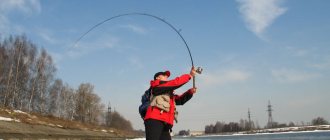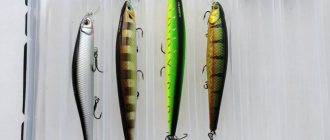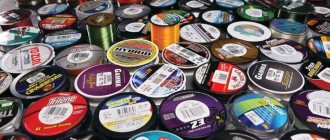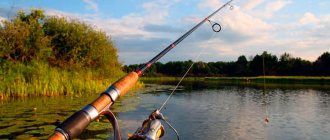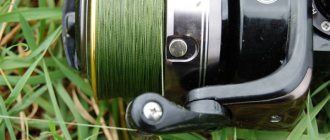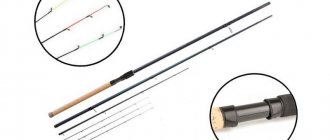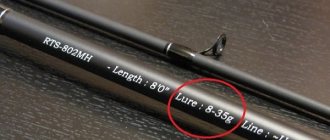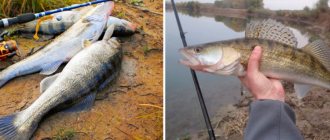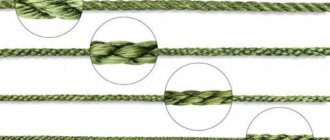Spinning fishing is a fascinating type of fishing that has become very popular in our country over the past two decades. Today, on the shores of reservoirs, you can meet a professional spinning rod player who clearly controls his every movement, and a boy of 6-7 years old with a spinning rod in his hands, who will one day also become a professional. This fishing method is based on imitation of the movements of a small fish that is part of the diet of predators. You need to throw the bait into a promising place and move it so that the underwater hunter has a desire to attack. This is a kind of game in which the one who is smarter, more cunning, and luckier wins.
Fishing with a spinning rod is interesting, challenging, and most importantly, sporty. This method can be caught even during the period of spring spawning bans, thanks to which the army of its adherents is replenished every year. However, not everyone succeeds right away. Spinning fishing is a real science, which for some people takes more than one season to master. To succeed in this matter, you need to at least assemble the tackle correctly (taking into account the conditions in which it will be used) and master basic wiring techniques. In addition, you need to be prepared for significant financial costs. Saving on bait is the most common mistake made by beginning spinners. They move around the pond with two or three spoons in their arsenal, spend a lot of time and effort, and the result is zero. This kind of fishing quickly becomes uninteresting.
Spinning - what is it?
This is the name of both the fishing method and the tackle, consisting of a rod, reel, fishing line and bait.
The rod is the basis of the tackle, everything else is auxiliary elements, each of which performs its assigned function. The operation of a spinning rod, like any mechanism or device, depends on the reliability of its components. If the rod breaks, the reel fails or the fishing line breaks, and the fisherman does not have spare parts with him, the fishing ends there. Using a spinning rod, bait is thrown into the water, and fish are hooked and landed. The coil is multifunctional, it is involved in all processes. The fishing line or cord ensures constant contact with the artificial fish. The bait itself, by its behavior in the water, provokes a predator to bite. It is equipped with a sharp hook or two or even three, so the underwater hunter who grabs it has little chance of freeing himself.
This is only the technical “side of the coin”, but there is another. For many fishermen, spinning is the meaning of their whole life and even a state of mind, if you like. They cannot work, eat, or sleep in peace; they look forward to the weekend so they can finally pick up their favorite instrument. And he, in turn, gives hope, makes the heart beat faster with every twitch of the rod tip.
Setting up and maintaining spinning reels
If you are new to spinning fishing, be sure to read the article on setting up a reel, where you will learn about installing it, winding it and adjusting the friction brake. There you will also learn about the concept of backing, which means pre-winding the fishing line onto the spool.
Reels, like any other mechanisms, wear out over time, and in order for the reel to last as long as possible, it must be periodically disassembled, cleaned and lubricated.
Regular cleaning and lubrication will significantly increase the service life of your reel; for more information about reel maintenance, read the article on disassembling and lubricating reels.
No one is immune from coil breakdowns and malfunctions. We have created a valuable article in which we described some coil malfunctions and how to repair them. Read more here - do-it-yourself coil repair.
Classification of spinning rods
Demand creates supply. Gear manufacturers quickly caught up with the trends and just as quickly filled the market with relevant products. Today in fishing stores you can see a huge number of rods for spinning fishing, which are difficult for even an experienced fisherman to understand. A beginner, getting into this “forest” (usually spinning rods stand vertically, in rows), simply gets lost and, as a result, buys what the seller sells him. That is, stale products that are not in demand. In order not to be among the deceived buyers, you need to know all the characteristics of the spinning rod and be able to select them for specific fishing conditions.
Let's start with the types of rods, of which there are only three:
- Solid – sensitive blanks up to a meter long, designed for casting bait over short distances. Ideal for fishing on small rivers and small lakes.
- Telescopic - rods consisting of two or more legs. They fold like nesting dolls, which is both an advantage and a disadvantage at the same time. When folded, the form is compact and easily fits in the trunk of a car, and this is a plus. The downside is that over time the joints of the knees wear out and the angler has to buy a new rod. In addition, telescopic spinning rods, with their excessive rigidity, are far from the most durable.
- Plug-in forms are two-part forms that are most popular among spinning players. Their only drawback is the inconvenience of transportation, but this is more than covered by reliability, durability, sensitivity and other qualities.
It should be noted that recently there are fewer and fewer telescopes in stores; they are being replaced by products with a plug-in type of connection. They are more versatile, so they are quite suitable for experienced spinners and are suitable for beginners.
How to make and equip a spinning rod for fishing
When all the components for the tackle have already been purchased, you can confidently begin assembly. Let us present how to assemble a spinning rod without errors in the form of the following list of sequential actions.
Having taken the purchased rod, we assemble it into working condition by articulating the knee for the plug-in type or pulling out the links for the telescopic type of tackle. The assembled tackle should not have any play or wobble at the joints. Then the reel is attached to the reel seat. The sliding components of the mount move along the butt of the rod, allowing you to insert the reel leg into the mount saddles. Having placed the leg in the saddle, tighten the fasteners until they are completely compressed. The correct clamping force completely eliminates side-to-side wobble of the reel.
After installing the reel, the cord is wound onto the spool of the mechanism. To do this, a braided cord is inserted into the tip of the rod, into the last ring, and passed along the entire length of the blank through the guide rings all the way to the reel. The line-laying arc opens in the reel and the cord is attached to the base of the spool. After attaching the cord, the bow is closed and the braid is wound to the required volume. Having completed winding the cord, proceed to tying the leash and attaching the bait. After securing the bait, the installation is considered complete.
To transport the spinning rod, when moving along the coastline, it is recommended to attach the bait to the bow of the line layer through a hook; in some types of fishing rods, a special fastener is provided for this purpose at the base of the blank, which makes the task easier, without deforming the tip of the fishing rod by strongly tightening the braid. Even a beginner in this fascinating business is quite capable of assembling a spinning rod correctly, following this sequence.
Read how to cast a spinning rod correctly for a beginner.
Material of manufacture
Spinning rods are made from different materials. Such products are made of fiberglass, carbon or composite. What is the difference?
Fishing rods made of fiberglass are strong, impact-resistant, and therefore durable. But at the same time, they are too heavy, rigid, completely insensitive, and you won’t be able to clearly control the bait with them. These are more suitable for fishing with feeders and heavy weights, for example, for regular donkey or feeder gear.
Carbon (graphite) products are lightweight and highly sensitive, which is very important in spinning fishing. However, carbon is a fragile material; a rod made of it can easily be broken by a blow from a branch or a heavy spoon. In addition, it costs several times more than fiberglass.
Composite spinning rods are considered the golden mean between the first two options, since both fiberglass and carbon are used in their production. It is a mixture of the mentioned materials with a clear interface. For example: carbon - 40%, fiberglass - 60%. Thanks to the decision to combine them, it was possible to obtain a cheaper rod, while maintaining lightness and sensitivity. This form forgives many mistakes made during the fishing process and significantly saves money. You can use them to buy wobblers or edible silicone, which is now expensive.
Advice. The term “graphite” on some Chinese products often misleads fishermen, so experts recommend focusing on price. If the cost of a fishing rod with such an inscription is 1000 rubles or less, this means that it is made of fiberglass (possibly with the addition of carbon).
Good producers
If we talk about companies, the companies that are most represented on the Russian market are Shimano (Shimano models catana or stradik), Daiwa, Kosadaka, and “Silver Brook”. If you read reviews on the Internet, then Korean spinning rods from the Maximus company are considered good.
But Chinese manufacturers have already learned how to make fakes of any models from different countries. Their rods are cheaper and, by the way, not bad. Don’t be afraid to buy China, it’s suitable for amateur fishing.
Those who engage in sports spinning and participate in competitions need special gear, which is very expensive, but this is a separate topic.
The video shows how to choose the best fishing rod:
Main characteristics
Length. Selected depending on the fishing method and conditions. The longer the rod, the further the bait flies when casting, so it is better to fish from the shore with long spinning rods from 2.6 to 3 meters. In addition to its long range, a long rod has another advantage - it makes it easier to navigate around water lilies, bushes and other obstacles in the water. This is more difficult to manage in a boat, and there is no particular need, because you can swim closer to any promising point. Therefore, shorter spinning rods with a length of 1.8-2.4 meters are suitable for fishing on a watercraft.
It must be said that a long tool is not always appropriate for sea fishing. If there are trees on the shore of a reservoir whose branches do not allow for a high-quality cast with a long rod, you have to take a shorter spinning rod.
Test. On spinning rods you can see markings in the form of Latin symbols and Arabic numerals. They indicate one important parameter - the permissible weight range of baits. It is also used to determine the class of the spinning rod. There are four main ones:
- UL (ultralight) - super-light, delicate rods with a weight of up to 7 g for fishing predators and sometimes small peaceful fish. Since the casting range of light baits weighing 7 grams or less does not exceed 20 meters, they are used mostly in the coastal zone.
- L (light) - spinning rods capable of throwing bait weighing up to 15 g over a distance of 25-35 meters, provided that the tackle is correctly balanced. This is the best option for catching schooling medium-sized perch and grass pike. Many spinners prefer to fish with this tool.
- M (medium) – middle class rods designed for fishing predators at medium distances (40-50 m). Since the lower limit of their test is usually 7 g, they can also be fished at a short distance from the shore or boat. That is, class M forms are universal.
- H (heavy) - powerful heavy spinning rods for catching large predatory fish, such as deep-sea pike, catfish, taimen. The lower weight threshold for baits that can be cast with such “sticks” starts at 40 g.
These are only basic classes of spinning rods, but there are also intermediate ones with average parameters. For example, ML or MN are medium-light and medium-heavy, respectively. Many manufacturers deviate from accepted standards and shift test boundaries at their own discretion, so you should first of all focus on the indicated grams. Build a spinning rod. Each form has some flexibility. The structure determines the amount of its bending under static load. According to this characteristic, all spinning rods can be divided into 4 groups:
- slow (parabolic) action - the entire working part of the rod is completely bent, marking - S (slow);
- medium action - the working part bends 3/4, marking - M (medium);
- fast action - the upper third reacts to the load, marking - F (fast);
- ultra-fast action - only the tip or about a quarter of the rod bends, marked Ex F (extra fast).
The structure affects the binding characteristics of the spinning rod, casting range, accuracy, and the efficiency of using certain baits. When choosing a fishing rod, you need to know that a slow action blank casts further, absorbs jerks well when fishing, and allows you to use thinner cords and fishing lines. At the same time, it is less sensitive, and because of its softness, casting accuracy and timely hooking suffer. Fast-acting spinning rods have their pros and cons. They are sensitive, reliably hook fish, throw the bait accurately, but the casting range leaves much to be desired. Also, due to poor depreciation, slippage during fishing is possible.
Seasoned spinning fishermen recommend that beginners first get a medium-action rod and use it to learn to feel the bait, work on mistakes, and hone their skills. As you gain experience, it will become clear which option to give preference to: fast action, slow action, or continue fishing with the medium one. What other advice can you give to a novice spinning player? It is very important to choose the right spinning rod.
Spinning line
As a base, either braided or monofilament fishing line is wound onto the spool of a spinning reel, and most fishermen use braided cords.
Braided cord is rigid and inextensible, unlike monofilament fishing line. Braided wire transmits the bite better and makes retrieving easier.
Braided cords are based on several threads that are intertwined. There are cords simply braided, and there are soldered ones; read more about all this in a separate article “braided fishing line (cord).”
Spinning equipment
The main task of a beginner is to select all the elements of the tackle so that it is as universal as possible. In this case, it can be used in different bodies of water and in almost any conditions. Note that a universal spinning rod does not exist in nature, but if desired, you can assemble a version very close to it. To do this, it is necessary to select the average characteristics of the elements. Let's start with the basics.
Rod
You can fish quite comfortably both from the shore and from a boat with a 2.7-meter long spinning rod. To use all types of spinners, wobblers and silicone baits, the weight of which ranges from 7 to 25 g, you should take a rod with a test load of 10-30 g. This lower threshold allows you to cast baits weighing 9, 7 and even 5 g, so not you should be afraid of him. But exceeding the test limits is already critical and risks breaking the new fishing rod.
Which system should I choose? Now they are producing transitional modifications in which approximately half of the working part is bent. This tuning is called medium-fast. This is nothing more than attempts by manufacturers to find that golden mean that allows you to cast baits far and at the same time feel them well during retrieving. Therefore, for an inexperienced spinning player, a medium-fast action form will be the best option.
You should not start your fishing career with an expensive and fragile carbon spinning rod. To begin with, it would be wiser to take a fiberglass rod. It is stronger and more reliable, and can withstand all the mistakes of a beginner. As for the type of knee joint, everyone is guided by their own preferences. Let us only note that the plug is more reliable, and the telescope is more transportable (of course, when folded).
Coil
Spinning reels existing today are divided into three types:
- inertial;
- inertialess;
- cartoon.
Not everyone is suitable for classic predator fishing using a spinning rod. An inertia reel or a drum reel is already a thing of the past; now only fly fishing gear is equipped with it, sometimes onboard fishing rods designed for fishing peaceful fish from a boat. The multiplier can be used in carp fishing or heavy trolling, but it is not suitable for classic spinning fishing. There is only one option left - a spinning reel or a meat grinder, as fishermen call it for the enormous amount of work it does when fishing.
There are a number of requirements for a spinning reel. Firstly, it must correspond as closely as possible to the class of the selected fishing rod. The lighter the spinning rod, the smaller the reel itself and, accordingly, the capacity of its spool should be. This characteristic is indicated in thousands of units and indicates how many meters of fishing line with a diameter of 0.01 mm fit on the spool. It follows from this that lightweight ultralight and light rods are compatible with small reels, the spool capacity of which ranges from 1000 to 2000, and for heavy jig spinning it is better to take a powerful grinder with a 3000 or even 3500 spool.
The second important point is the speed of rotation of the coil. On its body (usually on the spool), the manufacturer indicates the so-called gear ratio. For example, the numbers may be 4.6:1 or 5.2:1. If the first number is less than 4.8, this means that the reel is power and is more suitable for catching large predators with heavy baits on a slow retrieve. Values from 5.6 are a fairly high speed, and it is not always necessary. It's better to choose something in between. Meat grinders with a gear ratio from 4.8:1 to 5.2:1 are considered universal.
The quality of the reel is determined by the following characteristics: easy movement, even laying of the fishing line, absence of play, absence of uncharacteristic sounds (creaks), the ability to fine-tune the friction brake. By the way, the location of the clutch (rear or front) does not in any way affect the operation of the mechanism as a whole. It’s just that each angler chooses the option that is more convenient for him to handle.
fishing line
When it comes to fishing lines, spinners and all other fishermen have little choice. You can use either monofilament line or braided cord. Both have their advantages and disadvantages.
Monofilament has a certain stretchability and thereby helps the rod absorb the jerks of hooked fish. In addition, it costs an order of magnitude cheaper than wicker. Disadvantages: low sensitivity, may break when fishing for a trophy specimen or getting caught.
Braided cord is much stronger than regular fishing line of the same diameter, so it can withstand heavy loads. The lack of stretch makes it very sensitive, which is important in spinning fishing. Disadvantages: high cost, frequent formation of loops and beards.
Despite the softness of the braid, due to which it often gets tangled, experienced spinners recommend that beginners use it on their first spinning rod. With a braided cord, the casting distance will increase; it will transfer everything, even very weak bites, to the hand.
Leash
A leash is a mandatory component of equipment when specifically fishing for pike, as well as in those reservoirs where there is a possibility of this predator being bitten.
Leashes are:
- metal ones - sold in fishing stores or made independently from guitar strings.
- metal in a special braid - nylon braid protects against bends, which are then difficult to straighten;
- titanium - made of titanium fiber, the most convenient and reliable, but, unfortunately, expensive.
Some anglers use fluorocarbon leaders, which are made from fluorocarbon line that is invisible in the water. With these you can catch any predatory fish except pike, since fluorocarbon does not protect against its teeth.
Lures
Today there are many varieties of artificial baits designed for spinning fishing. Beginners should not start with complex “exotics” like mandula or Devon, these are for professionals. At first, you can master 3 types of simple and affordable baits, namely spinners, silicone baits and wobblers.
Spoons can be oscillating or rotating. Both are made from metal alloys and can have silver, gold and other colors. In our reservoirs, you can catch any predatory fish with spoons and spinners, except for pike perch and rotan.
Silicone baits include twisters, vibrotails, slugs, crustaceans and other imitation underwater creatures made from silicone. Silicone hooks are mounted on a jig head connected to an offset hook with an eared sinker or on a retractable leash that is popular today. Silicone bait can be used to interest any predator in our rivers and lakes, from small perch to giant catfish. Especially edible, with flavored “filling”.
Wobblers are a huge family of plastic and wooden fish of various shapes, colors, sizes, and so on. They can be floating, sinking or with neutral buoyancy, equipped with or without a blade, solid and composite (the body consists of two or more parts). Many models have a noise chamber inside for added appeal. In fishing stores, wobblers occupy entire sections, and it is difficult for a novice spinning angler to sort through so many lures. Therefore, to begin with, you can purchase only a few bladed baits of different shapes, sizes and depths. For example, minnows and cranks, they are easier to learn.
Spinner for spinning fishing
Spoons are metal lures of various shapes, colors and sizes.
Spoons come in the following types:
- wavering
- rotating
- Devonians
- spinnerbaits
Spinner baits are the simplest flat metal baits with a tee that move from side to side, resembling a wounded fish.
Spinners are a more complex bait that has a tee built into the axis and a petal that rotates around its axis.
Devons are a rare type of spinner that has a propeller instead of a blade, which creates vibrations during rotation.
Spinnerbaits are a special type of spinner that combines silicone bait.
Effective fishing methods
In order for a predator to become interested in the bait, it must be guided correctly in the water column. It is her movements that make her attractive, not herself. Fishermen use several types of fishing, in which predatory fish react to the bait. Let's look at the main ones.
Uniform wiring is the most popular. To perform it, you just need to rotate the reel handle at the same speed, without acceleration or pause. The depth at which the wobbler or spinner will go depends on the speed of rotation. By the way, only uniform wiring is suitable for a rotating spoon; any deviations will lead to a malfunction in its play. This method is usually used to fish in bodies of water with shallow depths: small rivers, river backwaters, lakes, stakes.
Stepped wiring involves scrolling the coil with pauses. Its essence is to force the bait to move along a certain trajectory, namely up and down. During a pause, the bait will sink to the bottom surface or approach it, and when reeling in, it will fly up again. This is how they are caught on large rivers and reservoirs. Those who can thoroughly master this technique are guaranteed good catches.
Jigging requires the use of a rigid spinning rod equipped with a high-quality reel and braided cord. This is quite an active technique. First you cast, after which you need to wait until the bait sinks to the bottom. This is followed by alternating several quick turns of the coil with 5-second pauses. Stopping is necessary for the bait to fall to the bottom. According to the observations of spinners who practice jig fishing, it is during pauses that the predator most often bites.
Soft baits
Soft baits are a silicone “model” mounted on a loaded hook or on an offset hook, which is part of a spaced rig that also includes a sinker.
Popular spaced snap-ins:
- diverter leash;
- drop shot;
- Carolina rig;
- Texas rigging;
All these rigs are discussed in detail in our article about rigs for pike (but they are used when catching many other predatory fish).
Silicone fish on a drop-shot rig
There are 2 types of loading:
- Classic (jig head) - lead weight with a soldered single hook and loop for attachment to the fishing line.
- A loaded hook is a “Cheburashka” weight with an offset, double or triple hook attached to it.
- Spaced rigging – when the bait is attached to an offset rig, and it is attached to a fishing line on which, depending on the type of rigging, the load is suspended in a certain way.
Types of jig baits:
Small twister from Relax
- Twister - a body resembling a maggot or pupa with one or several tails; when played in water, the twister takes the form of a fry. The tail has a very high-frequency play, which attracts perch and many other predatory fish.
- Vibrotail is a silicone fish with a bladed tail that wags left and right when retrieved.
- Rippers are a vibrating tail with a weight soldered into the body.
- Worms - pierced with a hook in the middle of the bait, used in drop-shot rigs.
- Octopuses are similar to twisters, but the body is noticeably shorter and has many thin tails.
- Foam rubber fish are polyurethane baits in the shape of a carrot or a fish with a two or three-hook hook inserted into the body and a weight carried out. Used in conjunction with loading the head part. When the foam fish falls to the bottom, it takes a vertical position, which is very attractive to pike perch.
In addition to their intended purpose, jig baits are also a common way to “probe” the bottom of a reservoir for changes in depth. In places where there are dense thickets of vegetation near the bottom and in the water column, it is worth fishing with bait with a special offset hook. The percentage of hooks in this type of fishing is, of course, somewhat lower than with an open hook, however, this significantly reduces the likelihood of the bait getting caught on grass or snags.
Rating of the best spinning rods - TOP 10
Every year new and improved spinning rods appear on the fishing market. Previous models also remain on sale, so it is difficult for beginners to make the right choice. Some are afraid to overpay, others do not fully understand what kind of tool they need. Let's try to help beginners with a rating of universal and at the same time budget spinning rods:
- SALMO Tioga 2.37M U-Light is an ultra-thin and light fast-action rod with a test load of 1-10 g. It weighs only 93 g and does not load the hand at all. With him, fishing will seem like a country walk. With a length of 2.37 meters, it throws far and can withstand weight up to 3 kg. An excellent option for catching perch, with which many begin their acquaintance with spinning fishing.
- SHIMANO Catana CX Telespin 165 UL - a durable compact blank made of composite weighing 89 g. Folded length - 45 cm, assembled - 165 cm. Test load - 10-20 g. From the shore, such a spinning rod is good for fishing an overgrown coastal zone, and When fishing from a boat, its compactness can be considered its main advantage.
- SHIMANO Vengeance AX Spin Tele 240M is an excellent six-section telescope designed for casting baits weighing from 20 to 40 g. Working length - 2.4 meters, folded - 68 cm. This rod can be described in three words: simple, reliable, budget.
- MAXIMUS Ichiro MSI22UL is one of the latest models from MAXIMUS, one of the leading manufacturers of fishing tackle. The spinning rod has a universal length of 220 cm, providing comfortable fishing both from a boat and from the shore. Another plus is high sensitivity, which allows you to control the position of the bait. Test – 1-10 years. With such a tool you can quickly move from the “beginners” category to the “professionals” category.
- BLACK HOLE Junior 632M/10-35 is a good option for jigging, durable, tough, sensitive and lightweight (117 g). It has a medium-fast action, can withstand loads of up to 9 kg, and differs from analogues in its proprietary tubular tip. Throws baits weighing up to 35 g. The kit includes a convenient storage case. It will be a reliable assistant for a beginner jig fishing enthusiast.
- ZEMEX Spider Z-10 802MH 2.44m 5-28g is a successful model with which you can successfully fish with both light baits up to 10 g and heavy 25-gram spinners. Suitable not only for those who have just begun to master the basics of spinning fishing, but also for experienced fishermen. This two-section fishing rod with a comfortable EVA handle will provide comfortable fishing and decent catches. What anglers like most about it is its versatility and casting accuracy.
- CAIDA Goddes7m 5-20g is a durable and lightweight carbon spinning rod with medium-fast action for all fishing methods, from even retrieving to complex twitching. Withstands fish weighing up to 5 kg. With such characteristics, its price, which is less than 1000 rubles, seems ridiculous.
- NORSTREAM Standart 862H is a tool for those who are ready to tickle their nerves in the fight against a large predator. A test load of 10-42 g allows you to catch the appropriate fish with large baits. This fairly powerful rod, 2.59 meters long, is equally suitable for shore fishing and fishing from a boat. It weighs only 191 g.
- BANAX Mega MS80LF2 is a good light spinning rod with a test weight of 2-12 g and a length of 2.44 meters, which throws 2-gram wobblers and spinners much further than many of its analogues. Very sensitive, shows the best results on uniform and jig retrieves. And spinners also call it indestructible. If necessary, you can throw silicone baits on jig heads weighing up to 20 g, and it will not break.
- STRIKE Pro Specialist Ultralight Spinning 1.65m 2-10g is a short ultralight tool for catching small predatory fish: grass pike, chub, perch, trout. It works best with baits from 2 to 6 g. Thanks to its slow action, it perfectly hooks a predator. An excellent option for honing your skills and gaining experience.
Compared to bottom and float fishing, spinning is much more dynamic and exciting. It involves frequent movements, changing places, camouflage, constant search for fish, one might even say stalking. This is somewhat reminiscent of hunting, only not in the forest, but on the water, and instead of a gun there is a reliable spinning rod. It’s not for nothing that millions fell in love with this tackle.
Spinning reels
Inertia-free or multiplier reels are usually used as reels. The most widely used are spinning reels, which are used in almost all methods of spinning fishing.
When choosing a spinning reel, you need to consider the following parameters:
- coil size
- type of friction brake (front and rear clutch)
- number of bearings
- spool shape and material
- gear ratio
- quality of line guide
- weight
